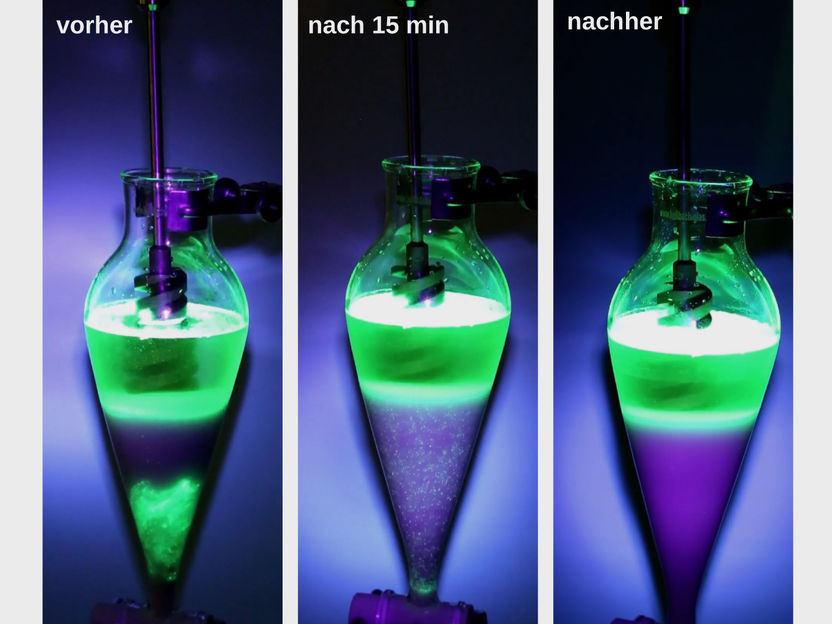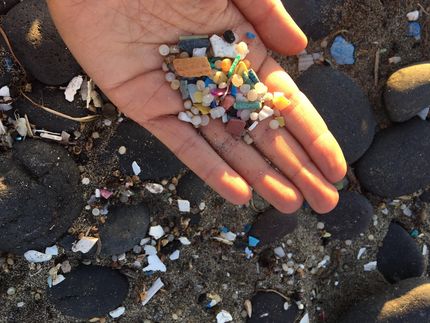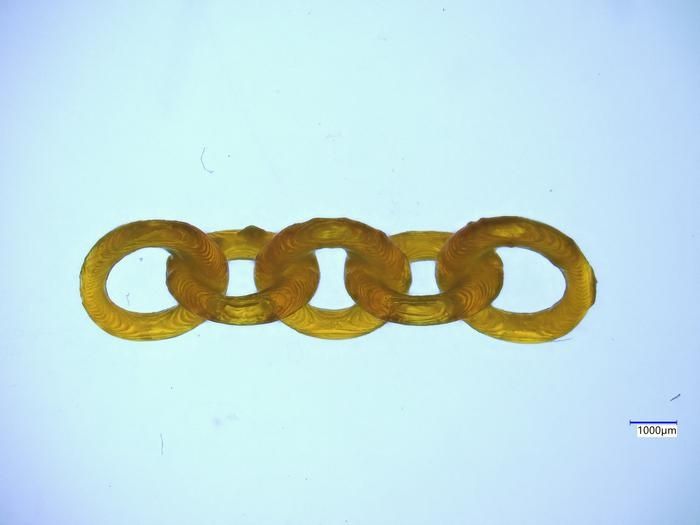When every particle counts
Comprehensive guidelines for microplastic extraction from environmental samples developed
Advertisement
Today, microplastics can be detected in almost every ecosystem in the world. Despite intensive research into this massive environmental problem, it is still a challenge to identify and quantify these synthetic particles made of various types of plastic in environmental samples. A team of researchers at the Leibniz Institute for Baltic Sea Research Warnemünde (IOW) has now for the first time compiled a comprehensive overview of methods that enables the use of standardized microplastics extraction workflows optimized for samples with very different properties. This includes methods newly developed at the IOW, among them protocols suitable for detecting particles smaller than 0.5 millimetres.

Newly developed at the IOW: Microplastics (green shining dots) can be separated from mineral sediment (blue-violet layer) by density separation using a separating funnel and a screw conveyor.
IOW / K. Enders
Whether on a Baltic Sea beach, in the sludge of local sewage plants, and on our fields or in the Arctic ice, in Sahara dust and deep-sea sediments – by now, researchers have detected microplastics everywhere. The artificial particles are not decomposed in natural cycles, but remain permanently in the environment. Since the phenomenon came into the focus of science around 20 years ago, a wide range of sampling, extraction and analysis methods have been developed and continuously improved to achieve higher accuracies and to adapt the methods to a wide variety of sample types and the broad range of different plastic materials.
“This is one of the major problems of microplastics research,” points out Prof. Matthias Labrenz. He heads the IOW working group “Environmental Microbiology”, which has been working on microplastics in marine environments for many years. “To better understand what microplastics pollution actually means for different ecosystems, it is important to reliably detect even the smallest particles – regardless of sample properties and which of the many different types of plastics is involved,” Labrenz continues. “Furthermore, the results of different studies must be comparable,” adds PhD student Kristina Enders, who as a member of the research group is working intensively on questions of how to detect synthetic particles in environmental samples. Comparability, however, is impossible in many cases due to the wide variety of methods, Enders explains. In addition, numerous detection methods are so complex that a large, meaningful sample throughput often is not achievable. “After all, we are looking for the proverbial needle in a haystack when we aim to detect the tiniest particles – often a lot smaller than 1 millimetre and sometimes masked by biofilms – among masses of other natural particles that can have quite different chemical and physical properties,” the IOW researcher elucidates the difficulties.
Kristina Enders, together with other colleagues from the Environmental Microbiology working group, therefore set herself the goal of developing a comprehensive overview of methods and process guidelines in the form of a decision tree, which for four common types of environmental samples – water, water sediments, sewage sludge and field soil – combines modular process steps into a suitable workflow, depending on the nature of the respective sample type. For this purpose, they reviewed a large number of existing microplastic extraction protocols, identified best practice methods, optimised individual process steps or added new ones that they validated thoroughly.
Enders explains the criteria that were used as a benchmark for the selected process modules: “To routinely separate plastic particles and natural sample fractions in standard laboratories, the respective method must be a so-called QuEChERS method: Quick, Easy, Cheap, Effective, Rugged and Safe. When developing the individual modules, we additionally made sure that they could be optimised for different sample sizes and were suitable for microplastic particles in the size range from 0.01 to 5 millimetres,” the lead author explains the approach of the recently published method overview.
For the extraction of particles smaller than 0.5 millimetres, processes were especially selected or newly developed, which preserve the integrity and therefore the detectability of the synthetic plastic particles but reliably remove the natural organic or mineral sample components by various chemical or physical treatments. One of these specialised separation methods, which was developed at the IOW for samples with many mineral sediment particles, is the density separation by means of a spiral conveyor in a separating funnel filled with a dense aqueous solution.
“With every advance in microplastics research, it has become apparent how complex and in many cases confusing just the field of detection methodology can be”, Kristina Enders and Matthias Labrenz agree. “With our overview of the best methods compiled in a decision tree we want to provide microplastics researchers worldwide with an orientational aid and advance the urgently needed standardisation of analytical procedures. Only if we significantly increase the efficiency of our studies and ensure that they are genuinely comparable, we will be able to come up with reliable conclusions about the environmental impact of microplastics and possible approaches to solving the problem,” they conclude.

































































